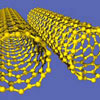 |
The concept |
| In 1959, physicist and Nobel prize laureate Richard Feynman presents "There's Plenty of Room at the Bottom" at a meeting of the American Physical Society and introduces the concept of nanotechnology – without naming it as such. |
 |
Definition and usage of the term nanotechnology |
| How can you describe how small a nanometer is? You can't. Well, you can but it still stays abstract. Furthermore, there is no such thing as "a nanotechnology". What we call nanotechnology is not an industry; nor is it a single technology or a single field of research. It consists of sets of enabling technologies applicable to many traditional industries. |
 |
What's so special about nanotechnology and why is it an issue now? |
| Chemists have dealt with naturally occurring nanoparticles all along. Think molecules or viruses. Toxicologists have dealt with nanoparticles that are the result of modern human life such as carbon particles in combustion engine exhaust. You might even say that we are surrounded by, and made of, nanostructures – atoms and molecules are nanoscale objects after all. So what is all the fuss about, all of a sudden? |
 |
New materials – the rise of carbon |
| There are plenty of examples of exciting nanomaterials we could write about – nanoparticles, quantum dots, nanowires, nanofibers, ultrathin-films etc. One example, though, that is exemplary of how an 'old' material gets an exciting new life through nanoscale technologies is the element carbon. |
 |
Nanomanufacturing |
| The only industry where nanoscale manufacturing technologies are employed on a large scale is the semiconductor industry where device structures have become as small as 20-30 nanometers. Of course, the chemical industry has long been working with nanoscale particles and pigments, but this falls more into the realm of chemistry than nanomanufacturing. |
 |
Some numbers – investments, papers, patents |
| Here is an overview of investment dollars that get spent every year globally, and the number of nanotechnology patents that get issued and nanoscience papers that get published. |
 |
Commercial applications |
| Don’t be fooled by crazy figures that tell you that the “nanotechnology market” is already hundreds of billions of dollars worth and will be worth trillions in just 5-6 years. Although there are a lot of exciting research results coming out of labs, the hard reality today is that so-called "nanotechnology products" are using only rudimentary nanostructures (e.g. dispersions in catalysts, nanoparticles in coatings and thin films, layers in electronics) incorporated in existing products or systems. |
 |
Industry example – energy sector |
| Nanotechnology solutions are already beginning to shape industries like electronics, medical technologies, advanced materials, or pharmaceuticals. Let’s take a look at the energy sector as a good example of how numerous small and not so small nanotechnology solutions can already be applied today. |
 |
The risk factor |
| In order to discuss the risks of nanotechnology, we need to take a closer look at these nanostructures. The mere presence of nanomaterials is not in itself a threat; as a matter of fact, nanoparticles exist in nature. It is only certain aspects that can make them risky, in particular their mobility and their increased reactivity. |
 |
Societal aspects |
| One potential problem with nanotechnologies is how it is being implemented and commercialized. Whereas for instance with nuclear energy you either build a nuclear power plant or you don’t and the introduction of the new technology is a very deliberate, hotly debated, and distinct act, nanotechnologies are creeping into our lives more or less unnoticed and to a large degree unquestioned. In particular, we'll look at nanomedicine and its implications. |
 By
Michael
Berger
– Michael is author of three books by the Royal Society of Chemistry:
Nano-Society: Pushing the Boundaries of Technology,
Nanotechnology: The Future is Tiny, and
Nanoengineering: The Skills and Tools Making Technology Invisible
Copyright ©
Nanowerk LLC
By
Michael
Berger
– Michael is author of three books by the Royal Society of Chemistry:
Nano-Society: Pushing the Boundaries of Technology,
Nanotechnology: The Future is Tiny, and
Nanoengineering: The Skills and Tools Making Technology Invisible
Copyright ©
Nanowerk LLC










